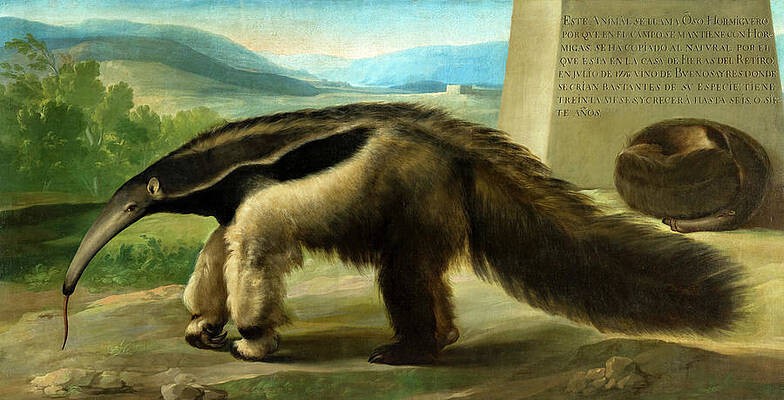- Cronología
- Ca. 1776
- Dimensiones
- 105 x 209 cm
- Técnica y soporte
- Oil on canvas
- Reconocimiento de la autoría de Goya
- Attributed work
- Titular
- National Heritage
- Ficha: realización/revisión
- 26 Aug 2022 / 15 Jun 2023
- Inventario
- MNCN.BA.0046
“ESTE ANIMÀL SE LLAMA ÔSO-HORMIGVERO/ PORQVE EN EL CAMPO SE MANTIENE CON HOR-/ MIGAS: SE HA COPIADO AL NATVRAL POR EL/ QVE ESTA EN LA CASA DE FIERAS DEL RETIRO:/ EN JVLIO DE 1776: VINO DE BVENOSAYRES DONDE/SE CRIAN BASTANTES DE SV ESPECIE: TIENE/TREINTA MESES, Y CRECERÀ HASTA SEIS, Ò SIE-/TE AÑOS”
Created for the Royal Cabinet of Natural History, later the National Museum of Natural Sciences where it is located today.
In July 1776 a gigant female anteater from Buenos Aires, was presented to Carlos III at the Royal Palace in Madrid. The King of Spain and the Indieshe King of Spain and the Indies ordered the animal's transfer to the Buen Retiro and commissioned its portrait, painted under the direction of Antonio Rafael Mengs, the first painter of his chamber, which is attributed to Goya on account of the stylistic similarities with the landscapes of his tapestry cartoons. This work was the first portrait of a royal commission that Goya painted and the first of his works to be exhibited in a museum in Madrid.
The painting was painted between July 4, when the presentation of the animal to the king was notified, and September 17, 1776, the latter date on which the Secretary of State in San Ildefonso ordered its payment in office addressed to Antonio de la Quadra.
The Anteater is depicted life-size in profile in the field, in a correct anatomical study typical of zoological images and prints of the period. It is not the only representation of the animal in this painting, as under the pyramidal monolith on the right of the scene there is another sleeping anteater curled up in a ball. This representation in two poses is in keeping with the descriptive nature of this type of informative work, as is the case in the prints of the Count de Buffon's Histoire naturelle.
Goya's most characteristic elements are to be found in the landscape, in its interpretation and in details: in the white sky that turns blue and the way it is painted, in the succession of hills on the horizon line, in the alternation of green, ochre and greyish blue tones, in the mass of trees that appears from the hollow and in the way the light strikes the trunks, branches and leaves, the faceted treatment of the rocks is also very typical of Goya's brush. And finally the small but striking quadrangular architecture are elements that bear no relation to Mengs or any other painter of the period.
-
2011pp. 242-252
